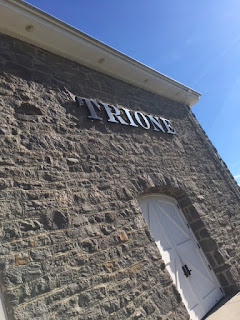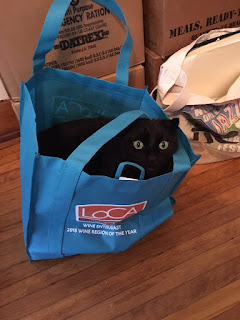 |
| Kronos Vineyard @ Corison Winery |
Confession: Napa Valley has never been my “go to” California wine region to visit. The wines are quite pricey and there can be an air of pretension at some of the larger tasting rooms. However, my experiences in Napa over the last year have helped me see that there is a whole lot more to Napa than egos and flashiness. Just like any wine region, it is hard to peg the region in one broad stroke (which I have been guilty of doing). Yes, there are plenty of stuck up tasting rooms, chateau after chateau that look like McMansions, and overpriced cult wines. But there is also plenty of honest, regional wine made in Napa. Wine made by individuals. Wines that are restrained. Good juice.
This old adage rings true: How do you make a million dollars in Napa? You start with a million. The cost of land and grapes is sky high, and with such a high barrier to entry, not all have what it takes to survive . For this reason, as a general rule, you’re not going to see cheapy $8-12 grocery store wine from “Napa”. The math just doesn’t add up. But not all wines from Napa are out of reach. Below is a summary of my visit to three wineries where you can expect to try some great wines with no pretense!
Corison Winery
Corison is a small, family-owned winery by Cathy Corison and her husband William Martin. Corison was founded in 1987 and their estate vineyard, Kronos, was purchased in 1995.
The tasting room is open by appointment only and is a “no frills” type of place. Here you are sure to try impeccable wines, with high prices to match, as their Cabs start at $100/bottle. However, this is a place that I would highly recommend. There is no attitude here. The wine is good. The people are great. And you will leave this tasting room, having learned things about Napa Cab that you might not have known before you came. That is the beauty of tasting room appointments. You get personal attention and the person leading your tasting (should) speak to you and walk you through the tasting at whatever level of wine knowledge you have. No need to feel embarrassed or inadequate.
There are two different tasting options. We went with the Library Experience which is generally $55/person (tasting fee waived with the purchase of 3 bottles of Cabernet or wine club enrollment). Though this tasting was waived for me as a member of the media. This tasting showcases their current releases and highlights a selection from their library. They also have a Collector’s Vertical Experience, which is designed for serious Cabernet collectors interested in a deeper understanding of how Napa Valley Cabernet Sauvignon can speak eloquently of time and place. This flight features four decades of Cabernet, including two of their single vineyard estate wines. This tasting is $150/person ($100 for wine club members).
2014 Corazón Anderson Valley Gewurztraminer $35
Grapes from Mendocino. No RS (residual sugar). Loved this guy….even took a bottle home. Great aromatics, good acidity, goes down easy.
1999 Corison Napa Valley Cabernet Sauvignon (no longer for sale)
This was a special wine to taste as it came from Cathy’s library and has 15 years in bottle. The wine has a lovely garnet color. On the nose I got faint black fruit (blackberry), black pepper, plus cigar and smoke. The palate had beautiful muted fruit plus cigar, smoke, tobacco, and leather. Firm tannins. This wine is showing its age, but it is holding up. It’s a masculine and dusty wine for sitting down with and really digging into.
2013 Corison Napa Valley Cabernet Sauvignon $90
This wine is a true Cabernet with Cab markers such as blackberry, black pepper and cassis. On the nose I also get bramble, and on the palate we also see plums. This is an outstanding wine with an Old World feel.
2012 Kronos Vineyard Cabernet Sauvignon $165
This is the only wine I tried from their estate vineyard, Kronos. This is a powerful wine with bright acid and fruit. On the palate we have juicy red and black fruit, including plum, cherry, and blackberry.
2006 Corison Napa Valley Cabernet Sauvignon (no longer for sale)
On the nose we have baked black fruit, like a coulis. Great acid, firm tannins, and medium + flavor intensity. This is a big boy that’s showing off at this point in its life.
Ehlers Estate
The tasting room of Ehlers Estate is located inside a gorgeous stone barn dating back to 1886. When I visited, the place was bustling with guests and energy. The vineyards are planted to Bordeaux varietals and by 2008, 100% of the Ehlers vineyards were certified organic. The tasting room is open daily and offers portfolio tastings for $35 (complimentary for wine club members). This is a great place to go for that picturesque vineyard feel with a warm and cozy tasting room.
“1886” Cabernet Sauvignon 2013 $110
A round and supple Napa Cab. I usually describe Napa Cabs as masculine, but this one has a soft femininity. Black fruit (blackberries), blueberries, black pepper on nose. On palate: blackberries, vegetal/bamble, chocolate/mocha/coffee.
Cabernet Franc 2013 $60
Perfumed and pleasing on the nose. Would love a simple grilled skirt steak with this. Red fruit (cranberry, cherry, pomegranate), floral (violets), vegetal, and vanilla notes. Espresso beans on palate.
Merlot 2013 $55
Red/black fruit (plum, cherry, raspberry, blackberry). Spice (vanilla, black pepper, cloves). Cedar/cigar box. Leather. This wine dances on my tongue and I get dark chocolate and a smokiness on the palate.
Sauvignon Blanc 2015 $28
Aged 6 months sur lie (which adds significant body and weight). Slightly restrained on the nose, but I can detect citrus (lemon), yellow apple, wet stone/minerality. On the palate I also get citrus (lemon), plus stone fruit (peach/apricot), salinity/brininess. This is a textured….almost chewy, which is not a descriptor I usually use for whites.
Trione Winery
Trione Winery & Vineyard is actually located in Sonoma County, but I felt it could be included in this wrap up, as they are very close to Napa. The Trione family has been deeply rooted in the Sonoma County wine industry for three generations, with the Trione Winery and brand starting in 2005. The grounds her are lovely with an equally comfortable tasting room (we even got a visit from the winery dog!).
Sauvignon Blanc Russian River Valley-River Road Ranch 2015 $25
A great wine and a great value! Stone fruit (apricot/white peach), minerality/wet stone, and smokiness.
Rosé of Pinot Noir 2015 $28
Citrus (lime), red fruit (strawberry, raspberry), and floral (rose).
Russian River Valley Chardonnay-River Road Ranch 2014 $34
This wine has gone through full malolactic fermentation (which is where the tart malic acid has been converted to a smoother lactic acid (which is found in milk!). The MLF gives the wine a creamy and buttery feel. The wine also shows bruised yellow apples, pear, and vanilla.
Russian River Pinot Noir-River Road Ranch 2013 $42
Red cherry, black pepper, gaminess, and forest floor, with an aging potential of 7-10 years.
Alexander Valley Henry’s Blend 2012 (35% Cab Sauv, 34% Merlot, 13% Petit Verdot, 13% Cab Franc, 5% Malbec). $56
A traditional Bordeaux blend, showing red + black fruit (plum, blackberry), pyrazines, and black pepper. This wine gives me Cab on the nose, but more Merlot on the palate (a velvet silkiness). Also lovely tertiary notes of smoke and cigar.
Alexander Valley Cabernet Sauvignon Block 21 $69
85% Cabernet Sauvignon, 9% Merlot, 2% Cab Franc, 2% Petit Verdot, 2% Malbec
What a wine! Baked/stewed black fruit such as blackberry compote and cassis, plus baking spices. Smooth, round tannins and 10-15 years aging potential.
Alexander Valley Primitivo 2013 $37
Stewed red fruit (plum, cherry), plus black fruit (blackberries and currants) and vanilla. French oak gives a nice cigar box feel.
Zinfandel 2013 $37
This one is aged in American oak. I get juicy black fruit (plums and blackberries). This wine is velvety, supple, rich.



















